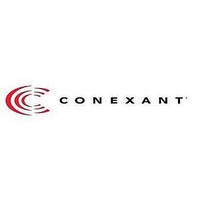RS8953 Conexant Systems, Inc., RS8953 Datasheet - Page 109

RS8953
Manufacturer Part Number
RS8953
Description
High-bit-rate Digital Subscriber Line (hdsl) Channel unit
Manufacturer
Conexant Systems, Inc.
Datasheet
1.RS8953.pdf
(173 pages)
Available stocks
Company
Part Number
Manufacturer
Quantity
Price
Part Number:
RS8953BEPF
Manufacturer:
CONEXANT
Quantity:
20 000
Company:
Part Number:
RS8953BEPJ28953-17
Manufacturer:
CONEXANT
Quantity:
1 238
- Current page: 109 of 173
- Download datasheet (953Kb)
RS8953B/8953SPB
HDSL Channel Unit
MPU access to the transmit routing table’s single (ROUTE_TBL) register is enabled by first setting
ROUTE_EN [CMD_3; addr 0xE7] to reset the table pointer. The MPU can then write up to 64 table entries
sequentially to the ROUTE_TBL address. The RS8953B increments the internal table pointer after each write to
ROUTE_TBL.
corresponds to the first transmit PCM timeslot, which is the 8-bit period starting at MSYNC’s rising edge.
Subsequent table writes increment the table pointer towards successive PCM timeslots. Standard E1 requires 32
table writes, corresponding to 32 timeslots. Standard T1 requires 25 table writes, where the F-bit location is
treated as the 25th timeslot. An Nx64 transmit PCM channel may require up to 64 table writes, corresponding to
the 4.096 Mbit/s data rate. After the MPU writes the required number of table entries, the MPU writes zero to
ROUTE_EN to prevent further table access, and then write TFIFO_RST [addr 0x0D] on every HDSL channel
to realign the transmit elastic stores if the aggregate HDSL data rate is modified. Subsequent table changes can
rewrite only the necessary entries up to and including the last desired modification.
ROUTE[1:0]
N8953BDSB
0xED—Transmit Routing Table (ROUTE_TBL)
Any writes beyond 64 will wrap around and overwrite the initial table entries. The first table entry written
—
7
INSERT_EN
Routing Code—Three identical routing codes are present in each table entry to select which
data source is routed to each one of three HDSL channel destinations (CH1–CH3). Route data
is available from three sources: PCM Transmit Serial data (TSER), PCM Insert Serial Data
(INSDAT), and PRBS generator data. In addition, TSER data is available from an 8-bit delay
buffer to allow routing codes to repeatedly (twice) use the same TSER byte as a data source.
PCM timeslot data can also be discarded by selecting no destination channels.
the same manner as TSER. INSDAT occupies delay buffer space and prevents routing of
previous TSER data during the timeslot following INSERT_EN. For example, if INSERT_EN
is active in the timeslot 1 table entry, then during timeslot 2, the delay buffer contains INSDAT,
and not the previous TSER. The PRBS generator is active only during timeslots that select
PRBS data which allows discontinuous timeslots to be tested with a single continuous PRBS
test pattern. Sequential timeslot routing is performed from inputs to destination channel(s)
without reordering of timeslots.
INSERT_EN on TSER, INSDAT, and PRBS data routing.
Note that INSDAT is available only from the 8-bit delay buffer, and cannot be repeated in
6
Figure 4-1. Transmit Routing
ROUTE[1:0]
5
ROUTE[1:0] CH3
00
01
10
11
4
INSDAT
Figure 4-1
Conexant
PRBS
TSER
Previous TSER (or INSDAT) from delay buffer
PRBS (or FILL_PATT, if PRBS_DIS = 1)
Source of Transmit HDSL Channel Data
INSERT_EN
Discard, do not route timeslot data
illustrates the effect of ROUTE[1:0] and
3
ROUTE[1:0] CH2
Delay 8
TSER
ROUTE[1:0]
Ch. 1, 2, 3
2
TFIFO1
TFIFO2
TFIFO3
1
ROUTE[1:0] CH1
4.10 Data Path Options
4.0 Registers
0
4-41
Related parts for RS8953
Image
Part Number
Description
Manufacturer
Datasheet
Request
R

Part Number:
Description:
RS-232C / DIP16 / DMP16
Manufacturer:
JRC
Datasheet:

Part Number:
Description:
Bluetooth RF Transceiver
Manufacturer:
Conexant Systems, Inc.
Datasheet:

Part Number:
Description:
Bluetooth RF Transceiver
Manufacturer:
Conexant Systems, Inc.
Datasheet:

Part Number:
Description:
ATM transmitter/receiver with UTOPIA interface
Manufacturer:
Conexant Systems, Inc.
Datasheet:

Part Number:
Description:
Service SAR controller
Manufacturer:
Conexant Systems, Inc.
Datasheet:

Part Number:
Description:
CN8223EPFATM Transmitter/Receiver with UTOPIA Interface
Manufacturer:
Conexant Systems, Inc.
Datasheet:

Part Number:
Description:
Embedded modem family
Manufacturer:
Conexant Systems, Inc.
Datasheet:

Part Number:
Description:
Fully integrated T1/E1 framer and line interface
Manufacturer:
Conexant Systems, Inc.
Datasheet:

Part Number:
Description:
Flicker-free video encoder
Manufacturer:
Conexant Systems, Inc.
Datasheet:

Part Number:
Description:
Home Networking Physical Layer Device with Integrated Analog Front End Circuitry Data Sheet (Preliminary) CX82100-41Home Network Processor (HNP)
Manufacturer:
Conexant Systems, Inc.
Datasheet:

Part Number:
Description:
Manufacturer:
Conexant Systems, Inc.
Datasheet:

Part Number:
Description:
Manufacturer:
Conexant Systems, Inc.
Datasheet:

Part Number:
Description:
Manufacturer:
Conexant Systems, Inc.
Datasheet:

Part Number:
Description:
Flicker-free video encoder
Manufacturer:
Conexant Systems, Inc.
Datasheet:











